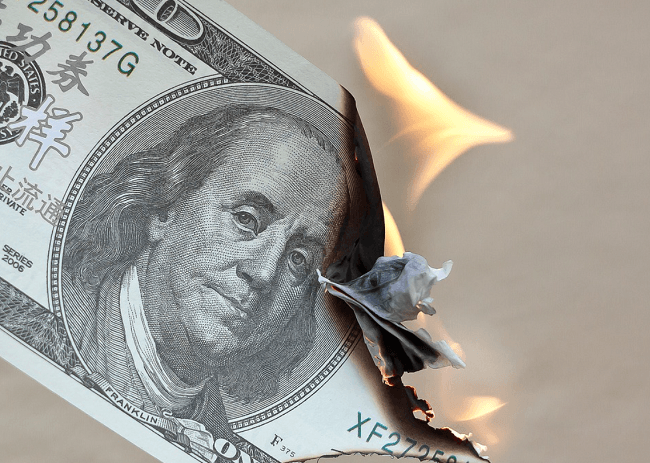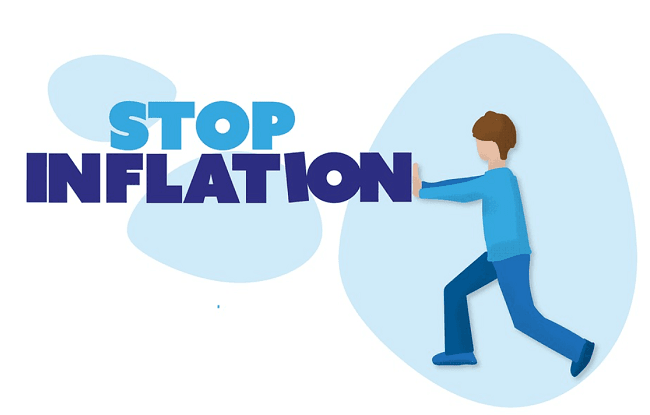Inflation is a rise in prices over a period of time. It can cause harm to the economy and become too high, resulting in economic upheaval or depression.
This article examines the causes of inflation, its effects and solutions.
Definition of Inflation
Economists define inflation as a sustained rise in prices of goods and services across an economy. This increase in money circulating leads to a decrease in purchasing power. The inflation rate is the percentage change in average prices over time. For example, if there has been a 3% increase in prices compared to last year, the inflation rate is 3% annually.

Ultimately, High inflation can arise from uncontrollable or controllable factors. These include
- government spending
- excess money creation by Central Banks
- wage rises
- commodities
- debt servicing costs
- low productivity growth
In serious cases, like hyperinflation or currency devaluation, Central Banks or governments may need to intervene to restore economic stability.
Types of Inflation
Inflation is an economic situation with a constant rise in the average price level of products and services in the long run. It can be measured in multiple ways based on the context of assessment. Generally, two types of inflation are discussed; demand-pull and cost-push.
Demand-pull inflation happens when total spending in an economy is greater than production capacity over an extended period. This results in higher prices of goods and services. Factors contributing to this include increased consumer demand, higher government expenditure, decreased taxes and interest rates, budget and trade deficits, and foreign capital inflows.
Cost-Push Inflation is caused by factors such as higher raw material prices, wages for production inputs like energy costs, wage costs, supply chain prices, etc. Labor market tightness generally leads to more wage demands, which can increase shipping and production costs, causing cost-push inflation. Other factors contributing to cost-push inflation include higher taxes by governments, and technological advances that increase productivity but also raise unit labor costs.
Causes of High Inflation
Inflation is an economic term that means prices rising over time. This can be bad for people, as it decreases their purchasing power. Knowing what causes it is important for managing it. Let’s look at the various problems:

Demand-Pull Inflation
Demand-pull inflation can happen when people want more goods or services than what’s available. Supply cannot meet the demand, and prices will go up due to the law of supply and demand. This type of inflation often comes from:
- Increased government spending
- Lower taxes
- A surge in imports or exports
- Increases in wages without a similar rise in productivity
- Low interest rates that lead to more spending.
Over-spending can also cause currency devaluation. This means people have to pay more for goods and services. Governments may increase taxes or sell bonds to remove excess money from circulation MyCCPay official site. However, this isn’t popular with citizens.
Cost-Push Inflation
Cost-Push Inflation is when prices go up because production costs have increased. This happens when inputs, such as wages, materials and fuel, get more expensive. As a result, prices of goods and services rise, and inflation occurs.
Employers tend to pass on the extra costs to consumers. For example, if wages rise due to union negotiations, businesses will make up for this by increasing prices. This puts pressure on prices, causing inflation.
Inflation can also be caused by monetary policies. If money supplies increase too quickly or interest rates stay too low for too long, inflation will occur. This means that all assets and goods cost more, and so do consumer prices.
Cost-Push Inflation leads to a vicious cycle:
- Businesses are always reassessing MyCCPay official site prices, pushing up consumer prices.
- This also puts pressure on employers to renegotiate wages, leading to further instability in the economy.
Structural Inflation
Structural inflation is caused by an economic malfunction. When demand for goods and services increases faster than production, suppliers try to get more money, leading to price hikes.
Population growth, higher wages, inflexible labor markets, expensive imports, or taxes and tariffs from the government can all cause structural inflation. Additionally, a decrease in resources can cause inflation if producers cannot replace them with equally priced alternatives. Governments also cause inflation by printing too much money or setting minimum wages too high.
Sometimes, structural inflation can be reduced with certain economic policies, like lowering taxes and tariffs. Governments should also carefully plan and regulate markets to make sure prices don’t skyrocket when the population grows or other economic changes occur.
Imported Inflation
Imported inflation happens when prices in one economy rise due to prices in another going up. This does not often involve exchange rates. It can be because of increased demand for imports or a sudden decrease in foreign MyCCPay official site output and trade. Nations that rely heavily on imports may be especially vulnerable to imported inflation.
For instance, if China’s economy weakens and its supply of product drops, the demand for these products could grow throughout the world, causing a rise in their price – resulting in higher inflation for countries that import MyCCPay official site goods. Imported inflation can also come from higher international prices because of global economic changes, such as an increase in oil or natural gas prices caused by geo-political activity. As these commodities are traded around the world, they can influence the cost of many imported goods.
Strategies to deal with imported inflation include:
- Tariffs
- Currency controls
- Protectionist measures like taxes on imports or production subsidies for domestic products.
Effects of High Inflation
Inflation on the high side brings about lots of changes in the economy. Prices rise consistently and stay that way. This has a huge effect on the economy. Consumers feel the pinch; investments dwindle, and even public services take a dip. So, it’s essential to understand the effects of high inflation.
In this article, we’ll look into what the consequences are:
Reduction in Purchasing Power
High inflation can be damaging. It reduces purchasing power, creating an unstable market. People are less able to buy items like homes and cars, so businesses slow down. This means fewer investments, jobs, and confidence. Large companies that rely on production suffer even more, as their costs go up faster than they can sell products.
Panic can hit markets too. Investors become anxious when their money’s value changes, and they make more careful decisions. This limits growth even more. In the worst cases, whole sectors could suffer if investors pull out their funds – potentially leading to a financial collapse or recession.
To prevent this, governments and central banks must take action, such as raising interest rates, to contain inflation.
Increase in Interest Rates
Interest rates can influence inflation. People think of it as higher prices, but it’s complex. Banks and governments make decisions that affect inflation. When people demand goods and services, businesses raise prices. Borrowing costs go up too, when demand for money is high. Interest rates rise to avoid further inflation. To stop an economic crash, governments may raise MyCCPay official site rates drastically.
Higher rates mean investors save more, not investing or buying assets. Central banks work with fiscal authorities to avoid a dampening effect on spending. They do this by:
- Adjusting taxes
- Giving incentives to spend
This helps the GDP instead of higher loan rates.
Increase in Unemployment
High inflation can cause unemployment to rise. Businesses struggle to keep up with rising costs and wages. This makes it hard for them to stay afloat, leading to job losses and fewer employment opportunities.
Plus, inflation can decrease consumer confidence. People then start to spend less. This hits businesses even harder, as demand falls and they can’t make profits due to higher production costs. To survive MyCCPay official site, businesses are then forced to reduce their workforce or close down.
Lastly, inflation also causes wages to go up without an increase in productivity or cost of living. This puts employers and employees in a bad spot. Without efforts to reduce inflation quickly, it can have major implications on unemployment rates and economic stability.
Solutions to High Inflation
High inflation can really impact an economy. So, we must find ways to reduce it! Possible solutions include implementing monetary policies and increasing aggregate demand.
We’ll look at the positives and negatives of each approach, to determine how they can tackle high inflation in the most effective way.
Fiscal Policy
Fiscal policy includes government spending and taxation. It’s a common tool to battle high inflation. When inflation rises, the government takes action to reduce demand. This is done by raising taxes, while decreasing public spending. This process should be gradual. Increase taxes and lower spending slowly to reduce inflation and maintain growth.
Monetary policy is another way to manage inflation. Central banks use policies such as higher interest rates to reduce demand and slow expansion. This slows down inflation but can cause a contraction if used too hard. Therefore, it should be used with caution. Nations also devalue their currency to discourage imported goods. This drives down domestic demand, putting downward pressure on prices and reducing inflation overall.
Monetary Policy
Monetary policy is the control of money supply and interest rates. Central Banks and other government entities use it to keep inflation levels in check. They manipulate the money supply and interest rates to reach a target, like low inflation or maximum productivity. This policy has been effective at controlling unpredictable inflation.
Some Central Banks favor policies that maintain low inflation, but not all. Some countries opt for expansionary monetary policy to stimulate their economy instead.
Tools for monetary policy include:
- Open market operations, when Central Banks buy and sell securities from commercial banks.
- Reserve requirements make commercial banks hold cash reserves.
- Discount rate structures set key lending rates for commercial banks.
The government uses measures like interest rate hikes or lower reserve requirements to implement monetary policy. This gives businesses an incentive to invest more, creating a healthier internal balance sheet and stabilizing prices. It also prevents illogical speculation with commodities like food or imports, which can lead to price increases without control.
Supply-Side Policies
The supply-side economic theory is a response to traditional economic management. It focusses on increasing growth by producing more, instead of simply hiring and demanding more. Incentives, taxes and regulations are adjusted to do this.
Two main tools are employed to fight inflation: fiscal policy and monetary policy. Fiscal policy uses taxes and government spending. Monetary policy manages money supply by controlling interest rates and bank requirements.
Supply-side policies help businesses to expand production. This increases consumption, which then brings price stability.
Fiscal policy measures to increase production include:
- Reduced taxes
- Capital investment
- Tax holidays
- Lowered trade restrictions
- Public-private partnerships
- Changed transfer payments
- Privatized state owned firms
- Venture capital schemes
- Lower minimum wage
Monetary policy tools for increased productivity are complex. They involve manipulating the amount of borrowed money and changing lending regulations. Central banks may intervene in markets and Easing programs can be set up when inflation builds up.
Conclusion
High inflation is a complex economic conundrum. It has damaging effects, such as lessened investment, more joblessness, lower wages, and a general dip in living standards. To control it, we must first identify its causes. This is usually determined by supply and demand forces in the economy – too much money compared to activity, or a lack of resources causing demand-pull inflation.
Governments can come under political pressure or support expansions that lead to more money creation than desired MyCCPay.
Controlling inflation requires a balance between consumption and foreign exchange rates, money expansion oversight, and fiscal discipline. This will keep prices within manageable limits and help the economy continue to grow without creating new issues.